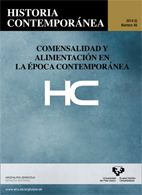Working-Class Diets in Late Nineteenth-Century Britain
##plugins.themes.bootstrap3.article.main##
##plugins.themes.bootstrap3.article.sidebar##
Abstract
Data from 6 surveys carried out between 1887 and 1901 were analysed for 151 families budgets divided into 5 income groups, ranging from those very poor families with irregular incomes to those keeping servants. The average weekly consumption of bread, potatoes, sugar, cereals, meat and milk was calculated, as well as the daily intake of energy, protein, carbohydrates, calcium and iron.
It was found that the first 2 groups got very poor diets, the 3rd group got a diet corresponding to average but still poor. An improvement could be observed with the 2 groups in the upper income range in all foods, particularly in milk.
Families spent 58% of their income on food. Bread, flour and potatoes were the staples among the families surveyed, providing 61% of total energy intake. Meat provided 11% of energy and 29% of expenditure. Status of foods also had an impact on intake; there may have been persistent prejudice against fruit, vegetables and milk.
##plugins.themes.bootstrap3.article.details##
diet, food, income, expenditure, vegetables, meat, milk, protein, carbohydrates
Authors publishing in the journal Historia Contemporánea agree to the following terms:
- Authors retain full copyright of their papers, but also grant copyright to the academic publisher (UPV/EHU Press) for the purposes of copyright management, vigilance and protection.
- Papers are by default published with a non-restrictive Creative Commons CC-BY-NC-ND 4.0. You are free to: Share, copy and redistribute the material in any medium or format. The licensor cannot revoke these freedoms as long as you follow the license terms. Under the following terms:
Attribution — You must give appropriate credit, provide a link to the license, and indicate if changes were made. You may do so in any reasonable manner, but not in any way that suggests the licensor endorses you or your use.
NonCommercial — You may not use the material for commercial purposes.
NoDerivatives — If you remix, transform, or build upon the material, you may not distribute the modified material.
No additional restrictions — You may not apply legal terms or technological measures that legally restrict others from doing anything the license permits.
- If an author requires a more restricted CC license (e.g. CC-BY-SA), this can be provided by contacting our publisher at: publications@ehu.eus
- In particular, and without having to request additional permission, CC BY-NC-ND licensed papers can be deposited in institutional repositories and academic web sites.
- Postprints (i.e. accepted but non-edited versions of the manuscript) can also be pre-published online, providing acknowledgement of authorship and source is specified as above.
For non-standard uses of papers or materials published in Historia Contemporánea, please contact our publisher UPV/EHU Press at: publications@ehu.eus

